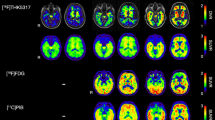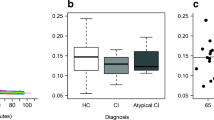Abstract
The utility of tau PET imaging in non-Alzheimer’s disease (AD) tauopathies like behavioural frontotemporal dementia (bvFTD), which is mainly underlain by TDP-43 or tau pathology, remains debated. We aim to test the hypothesis that [18F]-AV-1451 tau PET using later than usual acquisition times, which have previously been shown in AD to allow to get closer to tracer equilibrium between the reference region and high-binding structures, and could be better suited to the lower affinity of this tracer for the straight tau filaments present in non-AD tauopathies, would allow to detect cortical tau pathology in a fraction of bvFTD patients and in patients with non-fluent primary progressive aphasia (nfPPA, most often underlain by tau pathology). Sixteen AD patients, 11 controls, 7 bvFTD patients (including a carrier of a GRN mutation leading to TDP-43 pathology) and 2 nfPPA patients were included. We compared SUVr obtained at the usual early time window for [18F]-AV-1451 PET acquisition (ET: 80–100 min) to a later acquisition window (LT: 190–210 min) between groups. Compared with ET, [18F]-AV-1451 LT uptake in AD patients was significantly higher in the temporo-parietal cortex, and lower in subcortical regions. The LT window allowed to detect significantly increased tau binding in the frontal or temporal cortex in 3 bvFTD patients and in the 2 nfPPA patients that was not detectable with ET. The GRN mutation carrier showed no significant increase of tracer binding. [18F]-AV-1451 late acquisition window could allow cortical binding to abnormal tau deposits to be revealed in a subset of bvFTD patients, which may distinguish them from the TDP-43 subtype.



Similar content being viewed by others
Abbreviations
- AD:
-
Alzheimer’s disease
- bvFTD:
-
Behavioural frontotemporal dementia
- nfPPA:
-
Non-fluent/agrammatic variant of primary progressive aphasia
- PET:
-
Positron emission tomography
- CDR:
-
Clinical dementia rating
- GCI:
-
Global cortical index
- MMSE:
-
Mini-mental state examination
- PiB:
-
Pittsburgh compound B
- SUVr:
-
Standard uptake value ratio
- ET:
-
Early time window
- LT:
-
Late time window
References
Villemagne VL, Fodero-Tavoletti MT, Masters CL et al (2015) Tau imaging: early progress and future directions. Lancet Neurol 14:114–124
Chien DT, Bahri S, Szardenings AK et al (2013) Early clinical PET imaging results with the novel PHF-tau radioligand [F-18]-T807. J Alzheimers Dis 34:457–468
Marquié M, Normandin MD, Vanderburg CR et al (2015) Validating novel tau positron emission tomography tracer [F-18]-AV-1451 (T807) on postmortem brain tissue. Ann Neurol 78:787–800
Schöll M, Lockhart SN, Schonhaut DR et al (2016) PET imaging of tau deposition in the aging human brain. Neuron 89:971–982
Schwarz AJ, Yu P, Miller BB et al (2016) Regional profiles of the candidate tau PET ligand 18F-AV-1451 recapitulate key features of Braak histopathological stages. Brain 139:1539–1550
Marquié M, Siao Tick Chong M, Antón-Fernández A et al (2017) [F-18]-AV-1451 binding correlates with postmortem neurofibrillary tangle Braak staging. Acta Neuropathol 134:619–628
Lowe VJ, Curran G, Fang P et al (2016) An autoradiographic evaluation of AV-1451 Tau PET in dementia. Acta Neuropathol Commun 4:58
Cho H, Baek MS, Choi JY et al (2017) 18F-AV-1451 binds to motor-related subcortical gray and white matter in corticobasal syndrome. Neurology 89:1170–1178
Utianski RL, Whitwell JL, Schwarz CG et al (2018) Tau-PET imaging with [18F]AV-1451 in primary progressive apraxia of speech. Cortex 99:358–374
Smith R, Puschmann A, Schöll M et al (2016) 18F-AV-1451 tau PET imaging correlates strongly with tau neuropathology in MAPT mutation carriers. Brain 139:2372–2379
Spina S, Schonhaut DR, Boeve BF et al (2017) Frontotemporal dementia with the V337M MAPT mutation: Tau-PET and pathology correlations. Neurology 88:758–766
Cho H, Seo SW, Choi JY et al (2018) Predominant subcortical accumulation of 18F-flortaucipir binding in behavioral variant frontotemporal dementia. Neurobiol Aging 66:112–121
Son HJ, Oh JS, Roh JH et al (2019) Differences in gray and white matter 18F-THK5351 uptake between behavioral-variant frontotemporal dementia and other dementias. Eur J Nucl Med Mol Imaging 46:357–366
Tsai RM, Bejanin A, Lesman-Segev O et al (2019) 18F-flortaucipir (AV-1451) tau PET in frontotemporal dementia syndromes. Alzheimers Res Ther 11:13
Barret O, Alagille D, Sanabria S et al (2017) Kinetic Modeling of the Tau PET Tracer 18F-AV-1451 in Human Healthy Volunteers and Alzheimer Disease Subjects. J Nucl Med 58:1124–1131
Wimberley C, Lagarde J, Olivieri P et al (2018) Optimal time window for [18F]-AV-1451 binding quantification in AD using SUVr [abstract]. In: 12th Human Amyloid Imaging, Miami January 17–19 2018, p101.
Spinelli EG, Mandelli ML, Miller ZA et al (2017) Typical and atypical pathology in primary progressive aphasia variants. Ann Neurol 81:430–443
Hamelin L, Lagarde J, Dorothée G et al (2016) Early and protective microglial activation in Alzheimer’s disease: a prospective study using 18F-DPA-714 PET imaging. Brain 139:1252–1264
Rascovsky K, Hodges JR, Knopman D et al (2011) Sensitivity of revised diagnostic criteria for the behavioural variant of frontotemporal dementia. Brain 134:2456–2477
Gorno-Tempini ML, Hillis AE, Weintraub S et al (2011) Classification of primary progressive aphasia and its variants. Neurology 76:1006–1014
Sureau FC, Reader AJ, Comtat C et al (2008) Impact of image-space resolution modeling for studies with the high-resolution research tomograph. J Nucl Med 49:1000–1008
Varrone A, Sjöholm N, Eriksson L et al (2009) Advancement in PET quantification using 3D-OP-OSEM point spread function reconstruction with the HRRT. Eur J Nucl Med Mol Imaging 36:1639–1650
Mangin JF, Rivière D, Cachia A et al (2004) A framework to study the cortical folding patterns. Neuroimage 23(Suppl 1):S129–S138
Joachim CL, Morris JH, Selkoe DJ (1989) Diffuse senile plaques occur commonly in the cerebellum in Alzheimer’s disease. Am J Pathol 135:309–319
de Souza LC, Corlier F, Habert M-O et al (2011) Similar amyloid-β burden in posterior cortical atrophy and Alzheimer’s disease. Brain 134:2036–2043
Irwin DJ, Brettschneider J, McMillan CT et al (2016) Deep clinical and neuropathological phenotyping of Pick disease. Ann Neurol 79:272–287
Forman MS, Zhukareva V, Bergeron C et al (2002) Signature tau neuropathology in gray and white matter of corticobasal degeneration. Am J Pathol 160:2045–2053
Manjón JV, Coupé P (2016) volBrain: an online MRI brain volumetry system. Front Neuroinform 10:30
Marquié M, Verwer EE, Meltzer AC et al (2017) Lessons learned about [F-18]-AV-1451 off-target binding from an autopsy-confirmed Parkinson’s case. Acta Neuropathol Commun 5:75
Choi JY, Cho H, Ahn SJ et al (2018) Off-target 18F-AV-1451 binding in the basal ganglia correlates with age-related iron accumulation. J Nucl Med 59:117–120
Drake LR, Pham JM, Desmond TJ et al (2019) Identification of AV-1451 as a weak, nonselective inhibitor of monoamine oxidase. ACS Chem Neurosci 10:3839–3846
Hansen AK, Brooks DJ, Borghammer P (2018) MAO-B inhibitors do not block in vivo flortaucipir ([18F]-AV-1451) binding. Mol Imaging Biol 20:356–360
Baker SL, Lockhart SN, Price JC et al (2017) Reference tissue-based kinetic evaluation of 18F-AV-1451 for tau imaging. J Nucl Med 58:332–338
Wooten DW, Guehl NJ, Verwer EE et al (2017) Pharmacokinetic evaluation of the tau PET radiotracer 18F–T807 (18F-AV-1451) in human subjects. J Nucl Med 58:484–491
Schonhaut DR, McMillan CT, Spina S et al (2017) 18 F-flortaucipir tau positron emission tomography distinguishes established progressive supranuclear palsy from controls and Parkinson disease: a multicenter study. Ann Neurol 82:622–634
Harris JM, Gall C, Thompson JC et al (2013) Classification and pathology of primary progressive aphasia. Neurology 81:1832–1839
Bevan-Jones WR, Cope TE, Jones PS et al (2018) [18F]AV-1451 binding in vivo mirrors the expected distribution of TDP-43 pathology in the semantic variant of primary progressive aphasia. J Neurol Neurosurg Psychiatry 89:1032–1037
Makaretz SJ, Quimby M, Collins J et al (2018) Flortaucipir tau PET imaging in semantic variant primary progressive aphasia. J Neurol Neurosurg Psychiatry 89:1024–1031
Lanata SC, Miller BL (2016) The behavioural variant frontotemporal dementia (bvFTD) syndrome in psychiatry. J Neurol Neurosurg Psychiatry 87:501–511
Acknowledgements
The authors are grateful to the chemical/radiopharmaceutical and nursing staff of the Service Hospitalier Frederic Joliot for the synthesis of [11C]-PIB and [18F]-AV-1451 and patient management, respectively, the staff of the Centre de Neuroimagerie de Recherche (CENIR), Salpêtrière Hospital, for patient management during MRI acquisition.
We are also indebted to AVID Radiopharmaceuticals, Inc., for their support in supplying the AV- 1451 precursor and chemistry production advice.
Funding
This study was funded by the French Ministry of Health grant (PHRC-2013-0919), CEA, Fondation pour la recherche sur Alzheimer, Institut de recherche internationale Servier, France-Alzheimer.
Author information
Authors and Affiliations
Corresponding author
Ethics declarations
Conflicts of interest
The authors declare that they have no conflict of interest.
Ethical approval
All procedures performed in studies involving human participants were in accordance with the ethical standards of the institutional and/or national research committee and with the 1964 Helsinki declaration and its later amendments or comparable ethical standards.
Informed consent
Informed consent was obtained from all individual participants included in the study.
Electronic supplementary material
Below is the link to the electronic supplementary material.
Rights and permissions
About this article
Cite this article
Lagarde, J., Olivieri, P., Caillé, F. et al. [18F]-AV-1451 tau PET imaging in Alzheimer’s disease and suspected non-AD tauopathies using a late acquisition time window. J Neurol 266, 3087–3097 (2019). https://doi.org/10.1007/s00415-019-09530-7
Received:
Revised:
Accepted:
Published:
Issue Date:
DOI: https://doi.org/10.1007/s00415-019-09530-7




